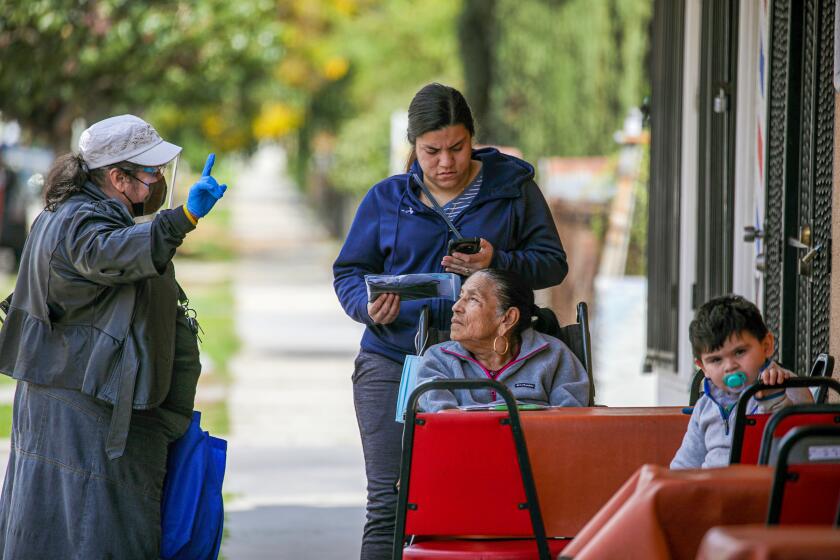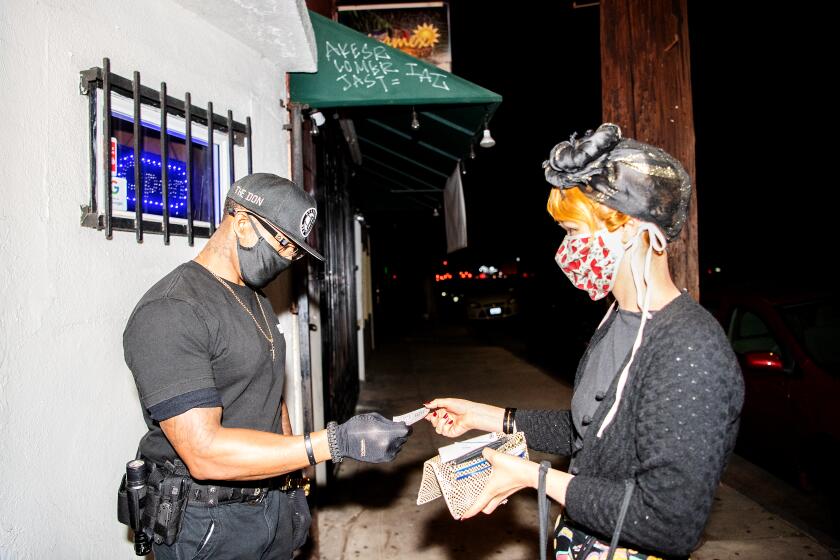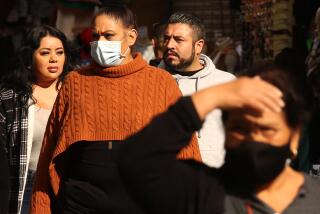L.A. County lifts indoor mask rule after hitting crucial milestone

Los Angeles County ended its indoor mask mandate after entering the low coronavirus community level set by the CDC.
Los Angeles County lifted its indoor mask order Friday after it officially exited the high coronavirus community level as calculated by the U.S. Centers for Disease Control and Prevention.
CDC data published Thursday afternoon showed that the county’s coronavirus community level had officially dropped into the “low” category.
Local health authorities waited for the CDC’s update before acting. County health officer Dr. Muntu Davis issued a new health order, effective Friday at 12:01 a.m., that lifted the indoor mask order, regardless of vaccination status, in places such as bars, stores, offices, restaurants, gyms and movie theaters.
Businesses can choose to retain their mask requirement for both customers and employees. And residents can still choose to wear a mask in any public place.
The revised order also relaxed some of the local vaccination verification rules. Vaccination verification is no longer required at outdoor mega-events — such as at theme parks, SoFi and Dodger stadiums, the L.A. Memorial Coliseum and the Hollywood Bowl — and no longer required in indoor portions of bars, lounges, nightclubs, distilleries, wineries and breweries.
The county still strongly recommends vaccination verification for outdoor mega-events and indoor bars and similar venues.
Vaccination verification or a recent negative test still will be required at indoor mega-events — those with more than 1,000 people, such as NBA games at Crypto.com Arena (formerly Staples Center) — which remains a statewide requirement. Vaccination verification also is required for healthcare workers and employees at nursing homes.
With the lifting of the mask order, Universal Studios Hollywood is no longer requiring visitors to wear masks or show proof of vaccinations or a negative COVID-19 test.
Even with the changes, California and L.A. County officials are still “strongly recommending” mask use in indoor public settings.
The state will continue to require mask use in indoor K-12 settings until the end of March 11. Starting March 12, school operators can decide whether to require masks indoors.
The CDC order requiring masks to be worn on public transportation, including planes, remains in effect. So do orders from the California Department of Public Health, which mandate mask-wearing in healthcare settings, nursing homes, homeless shelters, jails, prisons and emergency shelters.
Masking in indoor and outdoor public settings is still required in L.A. County for people with a coronavirus infection, for 10 days after symptoms begin or a positive test result.
The county’s relaxed rules do not alter stricter local vaccination verification orders, such as those implemented by the city of Los Angeles and West Hollywood. A city of L.A. ordinance, known as SafePassLA, requires businesses such as bars, indoor restaurants, gyms and movie theaters to check that customers are vaccinated against COVID-19.
Cities in Northern California with similar rules include Oakland and Berkeley. San Francisco requires customers of indoor gyms, restaurants and bars to show either proof of being up to date on vaccinations — including a booster shot, if eligible — or proof of a recent negative coronavirus test.
San Jose this week repealed an ordinance that required proof of a booster shot to attend a large indoor event at city-owned facilities. San Jose is now aligned with the state requirement to show proof of full vaccination or a recent negative test to attend those events.
L.A. County Public Health Director Barbara Ferrer said she’s strongly recommending that everyone still wear masks in indoor public settings until the risk for the most vulnerable further declines.
Wealth, poverty and race dramatically affect the toll of the coronavirus, with Latinos and Black communities in the county continuing to be hit hard.
Dr. Mark Ghaly, California’s health and human services secretary, also said this week that he’s strongly recommending mask use indoors statewide to further protect the vulnerable until case rates drop more.
Wearing a mask will help protect children still too young to be vaccinated as well as people who are at greater risk for worrisome complications from COVID-19, even if they are vaccinated, such as older people, those with weakened immune systems and people with chronic conditions, including asthma, diabetes, lung disease and heart disease.
Continuing to wear a mask also will help reduce the chance of an infection that could lead to “long COVID,” which can even affect people who didn’t suffer symptoms from a coronavirus infection. Long COVID can result in difficulty breathing, symptoms that get worse after physical or mental activities, and difficulty thinking or concentrating, sometimes referred to as brain fog.
Health experts say it remains prudent to avoid getting infected. Months from now, it’s expected that the risk of severe illness and death will be further reduced as more quantities of anti-COVID drugs such as Paxlovid become available in greater supply.
Most California counties, including San Diego, Orange, Riverside, San Bernardino and Ventura counties, allowed a universal indoor mask order issued by the state in mid-December to expire in mid-February.
The cities of Long Beach and Pasadena, which operate their own public health departments independent of L.A. County, followed suit Friday and Saturday, respectively. The city of Palm Springs lifted its mask order Monday.
Santa Clara County, Northern California’s most populous county, was one of the last counties in that region to keep a mask order, but lifted it Wednesday. Mendocino County still has a local mask order but is expected to reassess the need for one in the coming weeks.
Data dated Thursday and posted to the CDC’s COVID-19 Community Levels website showed L.A. County was reporting 111 weekly coronavirus cases for every 100,000 residents, a case rate about half of last week’s, which was 216.
L.A. County’s hospitalization levels are low enough to qualify the county to no longer be in a category in which the CDC recommends universal masking in indoor public settings. To get there, based on the most recently calculated case rate, L.A. County needed to report fewer than 20 new coronavirus-positive hospital admissions weekly for every 100,000 residents, and less than 15% of its staffed inpatient beds occupied by coronavirus-positive patients — a measure of hospital capacity.
L.A. County surpassed those goals. It has 7.4 new coronavirus-positive hospital admissions weekly for every 100,000 residents, and 5.5% of its staffed inpatient beds are used by coronavirus-positive patients.
Thursday’s CDC map placed most Southern California counties in the low COVID-19 community level, including San Diego, Orange, Riverside, San Bernardino, Ventura, Santa Barbara and San Luis Obispo counties. Imperial County is the lone Southern California county in the medium COVID-19 community level.
About 73% of Californians now live in counties with low COVID community levels; 22% live in those with medium levels; and 5% live in those with high levels, which include Kern, Tulare, Madera and Kings counties in the San Joaquin Valley; Tuolumne, Amador and Mariposa in the Sierra; and Mendocino, Del Norte, Trinity and Modoc in Northern California.
The CDC suggests universal mask wearing in areas with a high COVID community level, and says that higher-risk people may want to choose to wear a mask in areas with a medium level.
Los Angeles County is likely to lift its indoor mask order on Friday. The move is earlier than anticipated; it had been anticipated the county would make the change in mid- or late March. Here is what to expect.
California’s court system has decided to rescind four emergency measures, effective April 30, that have been in place for nearly two years, since the early weeks of the pandemic.
With the ending of those measures, state courts no longer may extend the time to hold preliminary hearings in criminal cases from 10 to 30 days; won’t extend the time to bring civil cases to trial by up to 60 days; won’t suspend state rules that bar the use of technology to conduct judicial proceedings and court operations remotely; and won’t adopt local rules without circulating them for 45 days of public comment.
California Supreme Court Chief Justice Tani G. Cantil-Sakauye announced the rescission of those orders Thursday after Gov. Gavin Newsom rolled back a number of pandemic-related executive orders.
“These events mark an important and hopeful change as the residents and government of our state transition to a semblance of pre-COVID-19 California,” Cantil-Sakauye said in a statement.
Times staff writer Hugo Martín contributed to this report.
More to Read
Sign up for Essential California
The most important California stories and recommendations in your inbox every morning.
You may occasionally receive promotional content from the Los Angeles Times.














